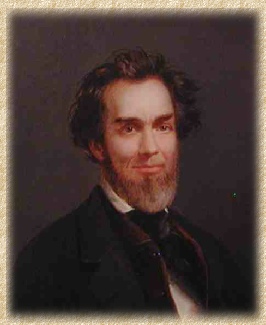Subject Guide

Mountain West
Malachite’s Big Hole
Alfred Jacob Miller:
Alfred Jacob Miller was not a Mountain Man, nor was he involved with the fur trade.
He is, none-the-less, a very important figure in our study of the Mountain Men,
for he was one of the foremost artists of the Far West during the period. A single
trip to the mountains in 1837 resulted in at least 166 finished works, including
portraits of Indians and Mountain Men, as well as scenes from everyday life in the
wilderness. The image to the right is a self portrait done sometime between 1855-1860
when he was in his late forties or early fifties.
including
portraits of Indians and Mountain Men, as well as scenes from everyday life in the
wilderness. The image to the right is a self portrait done sometime between 1855-1860
when he was in his late forties or early fifties.
Miller was born in Baltimore, Maryland on January 2, 1810. Early in his life he showed an aptitude for drawing. As a student, his schoolmaster would call him up "to destroy any caricatures) Miller had drawn on his schoolwork. Miller followed his interests in art and he received some early training in Baltimore. In 1831, Godfrey T. Vigne, an English visitor to Baltimore specifically mentions Miller as a promising artist.
With the encouragement and perhaps support of his family, Miller traveled to Europe in 1833 to pursue his training in art. He spent considerable time in Paris, but also traveled to Bologna and Venice and possibly to Switzerland.
By 1834 Miller had returned to Baltimore where he optimistically opened a studio. Little is known of his activities from this time, but it is probable that he was not successful because he is known to have illustrated sheet music for his landlord, possibly to pay rent.
Seeking a change in fortunes, he relocated to New Orleans in 1837, where he arrived with $30 in his pocket. Sometime in the early spring of 1837, shortly after his arrival, two meetings would take place which would forever change the direction of Miller's life. The first meeting was anonymous, a gentleman would enter Miller's studio, spend some time examining some of Miller's work displayed there, and after making a favorable comment about one of the pictures, leave. A few days later, this same individual, who introduced himself as William Drummond Stewart, returned to the studio with a substantive offer for Miller. Stewart informed Miller that he would be making an extended trip to the Rocky Mountains, and that he wished to have a competent artist accompany him to record the scenery and incidents of the journey.
Captain William Drummond Stewart was an eccentric Scotsman, a military officer, wealthy, and heir apparent to a large estate in Scotland. Stewart had already made several trips to the far west and in 1837 believed it would be his last such trip (in fact his last trip would be made in 1838, but Miller would not accompany him on the subsequent trip). The purpose of these trips was primarily for big game hunting. At least in 1837, Stewart’s party traveled with the American Fur Company pack train out of Independence, Missouri, traveling first to Fort William (Fort Laramie), and then on to the 1837 Rendezvous on the Green River near it's confluence with Horse Creek.
By late 1837, Miller was back in New Orleans where he commenced working up his sketches and drawings. In July 1838, Miller exhibited his Far West paintings in Baltimore. He continued to work up his drawings until October 1840, when he arrived at Stewart's castle in Scotland. Miller would remain here for over one year, completing his paintings.
After completing his work for Stewart, Miller traveled to London, where he remained for another year, finally returning to Baltimore in April, 1842. Here he established himself as a successful portrait artist. He also continued to duplicate his Far West works for local collectors. Alfred Jacob Miller died June 26, 1874.
For more information about Alfred Jacob Miller:
The West of Alfred Jacob Miller (1837) from the Notes and Water Colors in The Walters Art Gallery: Published by the University of Oklahoma Press, 1968. The watercolor illustrations in this book provide an excellent window into life in the Rocky Mountain West in 1837. As well as numerous portraits of Indians and Mountain Men, Miller portrays aspects of everyday life from butchering a buffalo, to setting traps, to evening campfire. The portraits have incredible detail regarding clothing, decorations and accoutrements. The broader scale drawings have a "mistiness" about them that obscures details of dress and equipment. Even still, these are valuable for details portrayed, such as wedge tents and type of wagons used.
Back to the Top
Back to The Men